I’m a big fan of Panic’s iPad app Status Board: it’s beautiful, and it’s easy to get your own data into. To that end, I took the PEI electricity data that I’m already scraping and created a CSV-formatted feed for Status Board. The result looks like this:
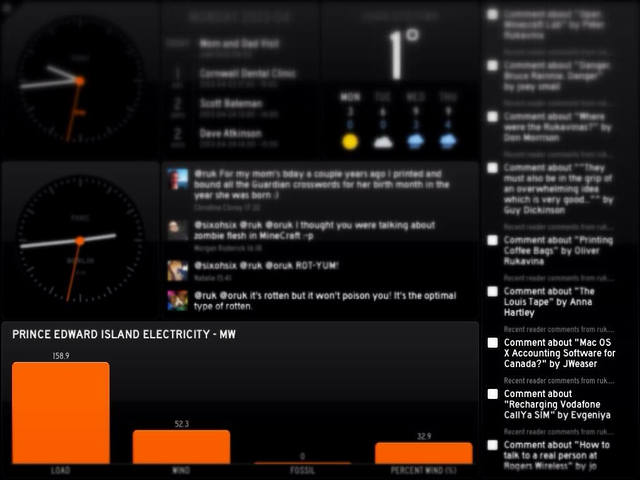
From left to right that’s the current electricity load, the current wind generation, the current fossil fuel generation (all of which are displayed in megawatts) and the percentage of the Island’s electricity load that’s being met by wind generation.
Today was the day to print the red layer on the Youngfolk & The Kettle Black coffee bags. It started off looking like this:
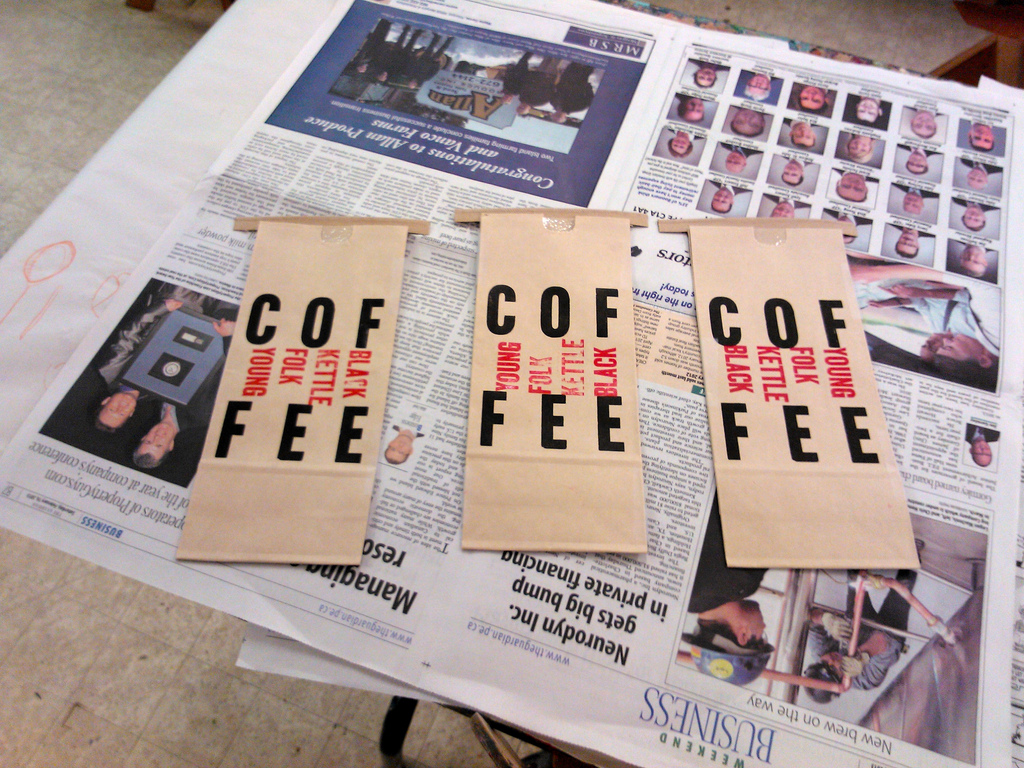
I struggled with various ways of squeezing “Young Folk Kettle Black” into the restricted space and position the coffee bag offered me (there are two vertical creases that need to be avoided). But no matter the orientation, I wasn’t happy with the result. I stared at each option. Walked away. Came back. Stared some more. And nothing made me happy.
So I took the chase off the press, took it upstairs, sorted the type back into its drawer, and started again, ending up with this:
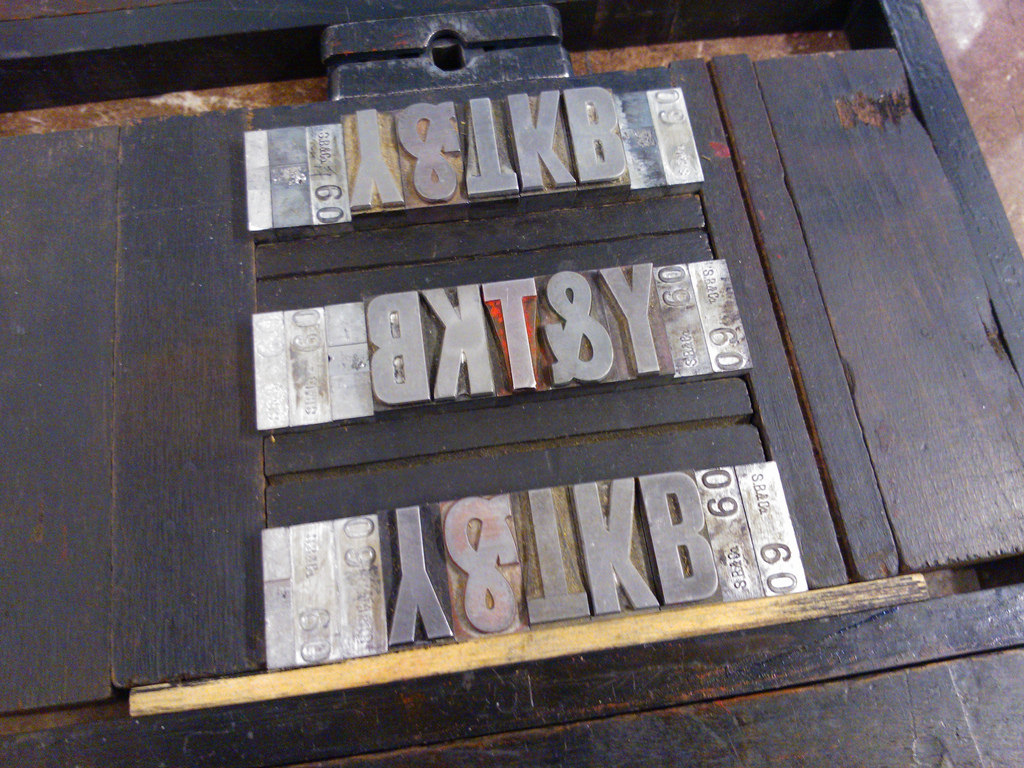
Which, when printed, looked like this:
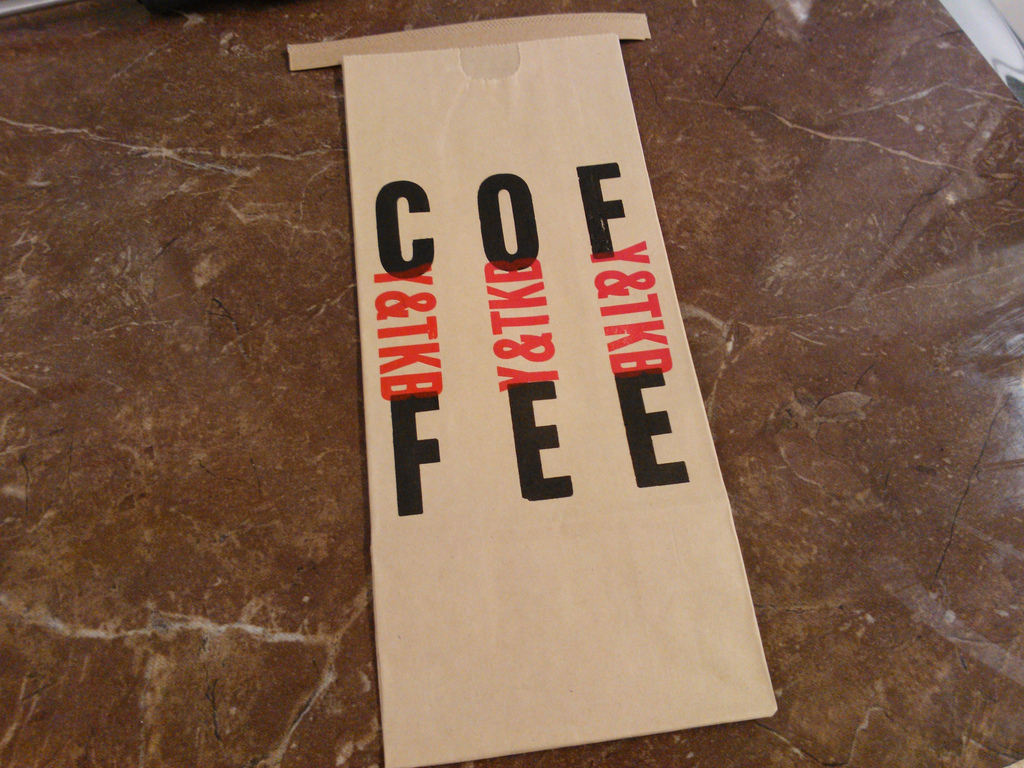
Which did make me happy. So I printed 160 bags:
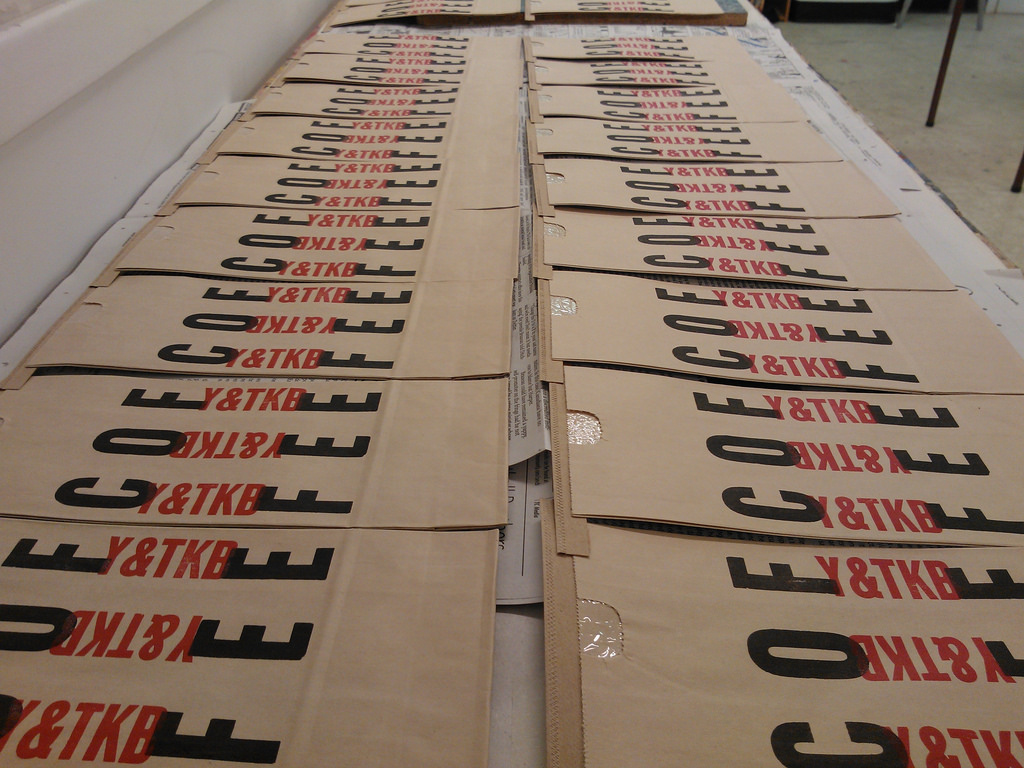
I’m quite pleased with the result, given the contstraints. The final test will be seeing the bags filled with coffee and on the shelves of the Youngfolk roasting operation up the street on Victoria Row.
Sometimes the only solution to a design problem is to break up with your original visions and come up with something entirely new.
Comics and crosswords are some of the most interesting parts of the daily newspaper, especially when you’re reading archival issues. Here’s the “Daily Crossword” from the Charlottetown Guardian, February 3, 1949, from a beta version of IslandNewspapers.ca. I’ve prepared a PDF version for those of you who want to print it out and party like it’s 1949. (I’m particularly partial to 4 down).

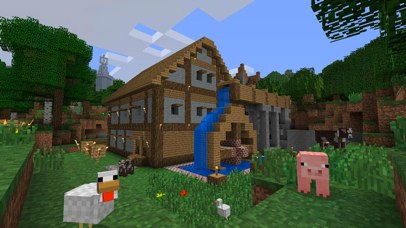
Our morning session on April 27 filled up quickly, so we’ve arranged for this second session, from 1:30 p.m. to 3:30 p.m.
Please note that this afternoon session is a nut free event to accommodate the needs of some participants.
About the Lab
An informal opportunity to come and play Minecraft, the popular world-building game, with other people.
The emphasis will be on sharing what we know, on learning new tips and techniques: so please come with questions and answers, and your curiousity.
Who can attend?
You can be an absolute beginner, or a longtime player: we want to create an space for players of all skill levels to teach each other.
There is no age limit; people under 18 are asked to obtain permission from parent or guardian to attend, and parents are welcome to attend too, either to play or just to learn and help.
The lab is limited to 40 attendees, and you must register a spot in advance if you want to attend (parents or guardians accompanying player do not need to register).
If you registered for the April 20 lab, please let others register for this workshop as that lab filled up quickly and we know there are others who would like a chance.
Where is it?
The lab will be held in the Modern Language Lab at Robertson Library, University of PEI.
There is free parking on the UPEI campus, and the Charlottetown Farmer’s Market is just across the street and is a good place to stop for breakfast before or lunch after.
The lab is equipped with thirty 20” iMacs and 20 PCs. We’ll be running our own Minecraft servers in the lab so that players can play together; we’ll have both a “survival” and “creative” mode server running.
How much does it cost?
The workshop is free.
You do NOT need to have a Minecraft account (but you can use your Minecraft account if you have one).
What do I need to bring?
You don’t need to bring a computer: we have enough Macs and PCs so that everyone can use their own.
Question from Parents?
Minecraft is being used by educators to teach everything from technology to engineering to math to architecture. The MinecraftEdu website is a good clearinghouse for information about the use of Minecraft in schools.
This lab is being organized by Peter Rukavina, Hacker in Residence, University of PEI. You can phone me at (902) 892-2556 or email prukavina@upei.ca is you have any questions or concerns.
I hosted my first Open Minecraft Lab yesterday in Robertson Library at the University of PEI. Because one of the goals of the project is to spread word of our experiences, I’m documenting here some of the details of how we set things up, and how the day went. I’ll update this next week after we have our second session.
Registration
 Because there are a limited number of computers in the labs, it seemed wise to have people register in advance. There are 29 Macs in the Modern Language Lab and 20 PCs in the LINC lab next door; I set the capacity at 40 to account for extra people showing up, parents who wanted to play, and equipment failure.
Because there are a limited number of computers in the labs, it seemed wise to have people register in advance. There are 29 Macs in the Modern Language Lab and 20 PCs in the LINC lab next door; I set the capacity at 40 to account for extra people showing up, parents who wanted to play, and equipment failure.
To manage the registration itself, I used Drupal 7 and the Node Registration module, a module that allows any type of Drupal content to have registrations attached to it.
I set up a new “workshop” content type in Drupal, with a datetime field for the start and end of the registration, separate “registration starts” and “registration ends” fields, and a field for capacity, and then wired these fields up to the Node Registration settings.
I then simply created a new “workshop” node for the April 20 Open Minecraft Lab, with a description of the event, and the dates and times and capacity set appropriately. The end effect was that a registration form was automatically attached to the node when it was published, and each time a registration was received the number of “available slots” was decremented by one so that when all 40 slots were filled registrations were closed.
A few lessons learned here:
- I originally didn’t allow more than one person per “registration”, but soon found that parents with more than one child wanted to register them both and hit the restriction of “one registration per email address” imposed by the module. To work around this, I modified the Workshop content type and the Node Registration settings to enable a drop-down list selection of 1 to 3 “slots” to be consumed by each registration.
- I didn’t anticipate the workshop filling up entirely, and didn’t realize that the registration form would disappear when it did, so I had language in the body of the workshop node that said “fill in the registration below” which people who encountered the node once registration closed found confounding (and resulted in 4 or 5 emails and a couple of voicemails). To solve this, I simply removed this language and added a bold, highlighted note to the form once registration was closed.
- Also to this end I built a Drupal View (Node Registration has excellent Views support) that displayed, one the front page of this website, the capacity and available slots for each lab.
The first 25 slots filled up in about 24 hours; I was able to open up the second lab two days later and the remaining 15 slots filled up in another 24 hours and I continued to get requests for additional spots that I had to turn down. In the end almost everyone came, but there were about 8 PCs that went un-used, mostly because there was no hardware failure, and no parents choose to play, so I could have booked in more participants.
The age of the participants ranged from 6 to 15; the average age was 10. There were 3 girls and 37 boys registered.
What to do with the parents?
One of the things I wanted to stimulate was parents and guardians and their kids playing Minecraft together, or at least learning together. I also didn’t want to be solely responsible for wrangling 40 kids by myself, so I encouraged parents to stay and participate.
What ended up happening was a mix: some parents and guardians left to go shopping or run errands, some sat beside their kids and watched or helped, some hung out in the lab, and some took advantage of the resources of Robertson Library.
There turned out to be no “wrangling” issues at all: the participants were all great.
I’d still like to get parents playing Minecraft, though.
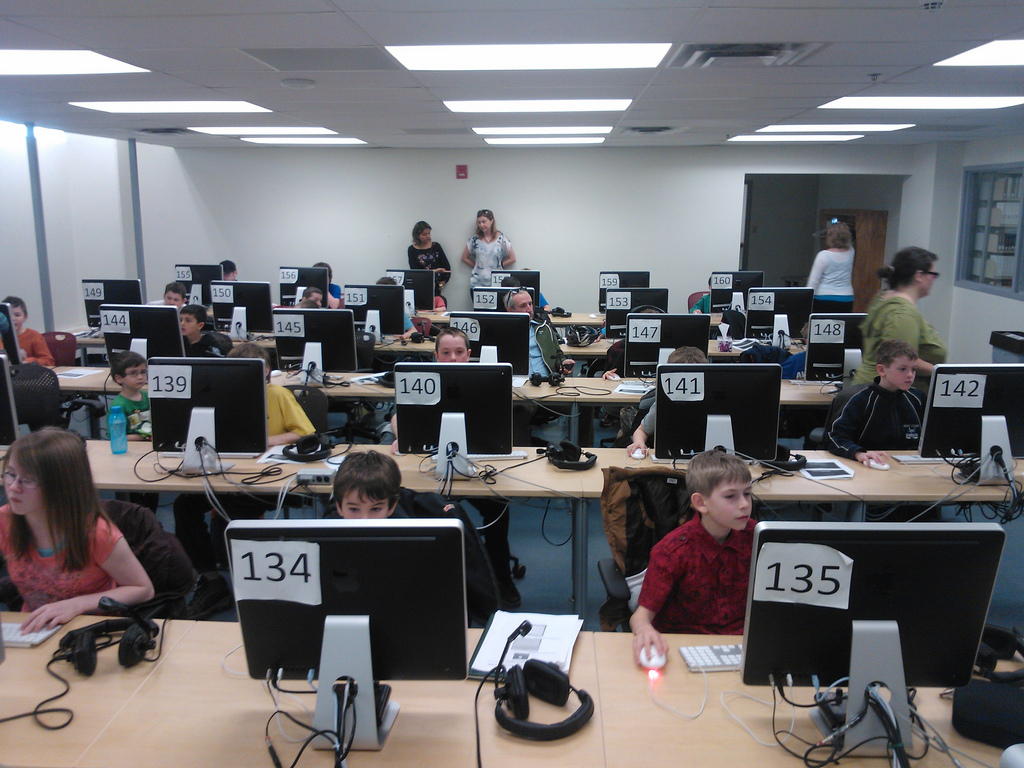
Hardware and Software
Robertson Library has a very good setup, hardware-wise, for hosting labs like this.
The Modern Language Lab has 29 Macs with the username and password pasted on the front and home directories that reset on logout, meaning that people who login are free to do pretty much anything – install software, change settings, etc. – in a way that won’t adversely affect the next person to come along.
Similarly, the PCs in the LINC lab next door allow for software installation and settings changes (although they’re a little more vulnerable because they don’t reset on logout, to any changes that are made are persistent).
The Macs were clearly the better workstations: they’re newer, faster, have better screens, keyboards and mice and the Modern Language Lab is a much more pleasant space. The PCs are olders, grungier, have tiny screens, and seem as slow as molasses compared to the Macs. However Minecraft itself, once running, seemed to run equally well in either environment.
The PCs were lacking headphones or speakers and were thus silent; the Macs, being in a language lab, each had a hefty headset and boom microphone: some of the participants used these, but most didn’t, either because they didn’t need sound, or because the headsets were too heavy or too large for their heads.
Minecraft Server Software
I purchased the special education-focused “mod” of Minecraft called MinecraftEdu to run the Minecraft server on, and ran this on the instructor Mac in the Language Lab. Because this Mac is on the same LAN as all of the Macs and PCs in both labs, there were no networking issues to solve: all the workstations could “see” the server on the LAN.
The Minecraft server software ran without issue on the Mac and, indeed, the Mac seemed capable of supporting both the server and the client at the same time. Indeed, several of the participants asked to be able to run their own server – to create a private world with a few friends, for example – and this proved problem-free.
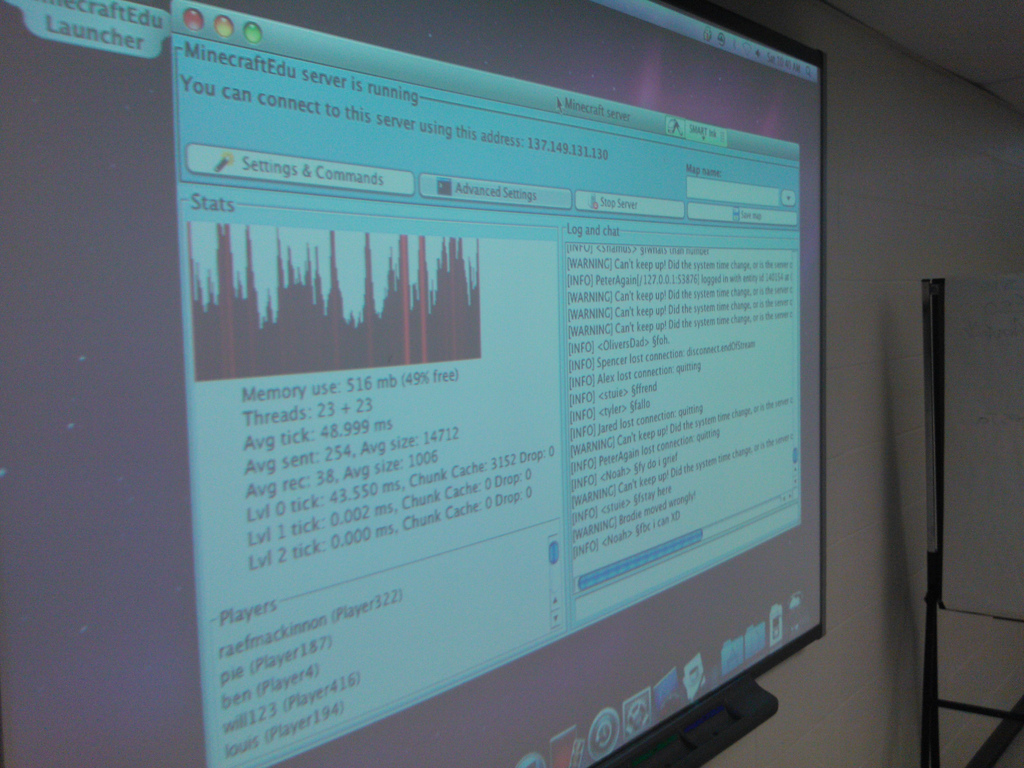
Minecraft Client Software
I also used the special MinecraftEdu client. Pre-installing this on all the workstations was going to be time-consuming, so I worked up a set of instructions for the Mac and PC, printed these out and put a copy in front of every workstation.
For the Macs, I used Apple Remote Desktop, which was already installed on the instructor Mac. It’s an amazing piece of software that allows the instructor Mac to install software, copy files and observe and control workstations in the lab. The one limitation I found was that the workstations need to be logged in to be able to copy files, so I had to have each participant login, and then raise their hand so I could then copy the Minecraft client installer to their desktop. This worked well, but it slowed things down a little.
For the PCs, I took advantage of a shared network drive accessible by all of the workstations on bootup: I put the Minecraft installer in that directory, and participants simply ran it from there.
Most everyone was off and playing Minecraft within 10 minutes of arriving, and other than a copy of clients that crashed and a few that got their Minecraft controls reset, everything went well technically.
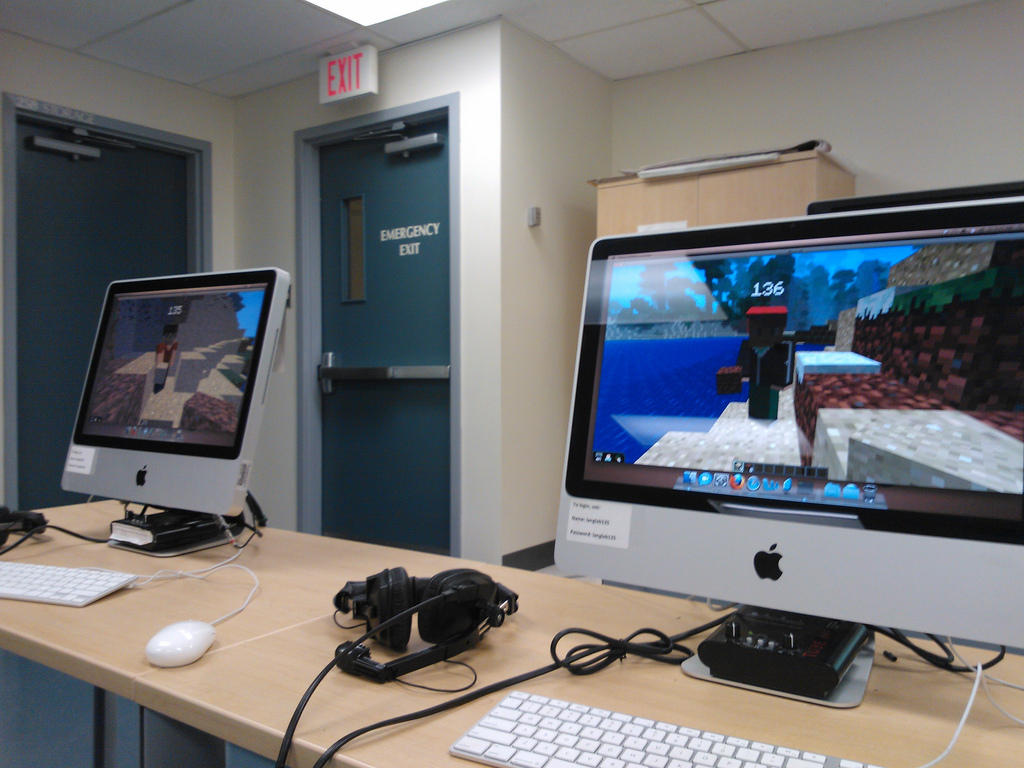
What about Minecraft accounts?
In general, playing Minecraft requires having a Minecraft account, which costs $26.95 is is available for purchase online. The MinecraftEdu project offers educators discounted $18 accounts (sold as “gift codes” redeemable from Minecraft itself). Of the 40 registrations received, most already had a Minecraft account, and so I purchased 5 discounted accounts to distribute as needed.
As it turned out, it’s possible to play the MinecraftEdu client in “offline” mode – good for situations where the clients are behind a restrictive firewall – and when this is done there is no prompting for a Minecraft account. To keep things simple, our instructions were tailored to running Minecraft in this mode; participants were welcome to login with their Minecraft accounts if they wanted to, but this wasn’t required. This discovery was positive as regards to prospect of running a Minecraft lab inside schools: as long as the MinecraftEdu server and client can be installed on workstations in a school, there should, in theory, be no need to deal with networking or firewall issues.
Playing Minecraft
I knew going into this experience that I knew next to nothing about Minecraft and that almost everyone attending would know more than me. That’s why I titled the event a “lab” and not a “workshop” or a “seminar” or a “camp.” The idea was that people could come and play Minecraft with each other, and in doing so they could learn from each other and I could learn from all of them.
This is exactly how it worked out. When I got a question I couldn’t answer, I tried my best to hook up participants with questions with those that might have answers. There was a running chat inside Minecraft itself where I could see questions being asked and answered, and questions like “how do I stop flying” got shouted out and quickly answered.
There were a couple of really helpful participants who took time out of their own gaming to help others, and that was a big help.
I started off the Minecraft server in “survival” mode, but without monsters, which I figured provided a good challenge but less to fear for younger players; about 45 minutes into the lab I started to get requests to put the server into “creative” mode, and to avoid interrupting people mid-game, I installed a second server on one of the Macs in “creative” mode and those that wanted to play on it could just change the IP address of the server they were connected to.
By the end of the day there were also two participants running their own servers on their Macs, either because they wanted things configured differently or because they wanted a private world to play with a select few others. Those running their own servers got to set a “teacher” password on start, which allow them to then experience the variety of special MinecraftEdu teacher-focused settings (being able to teleport others, being able to turn on and off game features, etc.).
Griefers
Griefing is a part of the Minecraft culture to the point where it has its own page in the Minecraft wiki where it’s described as “the act of irritating and angering people in video games through the use of destruction, construction, or social engineering.” I didn’t know the term until I started to hear it shouted out – “whoever’s griefing, please stop it!”. What was happening is that some kids were spending a lot of time building houses and buildings and other constructions, and others were going around blowing them up or smashing them (in hindsight this was partially my fault, as I enabled the “allow fire and TNT” setting in the server).
At one point I was called upon to “do something about the griefers,” but opted not to, both because I had little idea exactly what I’d do (identify the griefers and ban them?), and also because I didn’t cast myself in the role of managing the virtual environment: if the participants wanted to control griefing, they’d need to figure out a way of doing it themselves. As it turned out, the lab ended before this really came to a head, but I’m thinking about next week’s lab and possibly options: I might run a server with various anti-griefing mods applied, I might run two servers, one “free for all” and one more disciplined. Or I might just let it work itself out.
Helpers
My son Oliver helped the night before with setup and testing (part of the reason things went so well technically is that we tested all the instructions a couple of times and updated them as we encountered problems). Frances Squire, a grade 9 teacher from Birchwood Intermediate who is deeply engaged in technology education, was a great help, solving technical issues and helping to create an air of civility. And several parents jumped into the breach to help solve technical issues.
The participants themselves were a great help to me and to each other, sharing what they knew and sharing what they learned. The vibe in the lab was generally helpful and open, and I think everyone came away feeling positive about the experience.
Jerrad Gilbert, who provides technical support services for Robertson Library, was an invaluable help in guiding me through the ins and outs of the hardware and software setup in the labs; he was patient and helpful and I can’t imagine having pulled off the lab without him.
And of course the “openness” of the labs themselves, which reflects an underlying openness of the library, made all of this possible: all PEI teachers should be exposed to the Modern Language Lab at UPEI to see what a well-resourced, progressively-managed educational computer lab looks like.
What’s next?
We have another lab scheduled for next Saturday morning that’s already fully booked. I’ve asked whether it might be possible to open up an afternoon session for next week to allow for more registrations and I’m waiting to hear back. In general I’ll run things next week as I did this week, although I’d like to be able to take more time to observe and to play myself.
In our Open Minecraft Lab in Robertson Library, we’ll be playing the special custom MinecraftEdu version of Minecraft, which has some education-friendly features built into it.
I’ve prepared a step-by-step guide to installing MinecraftEdu on the Macs in the Modern Language Lab and the PCs in the LINC lab.
For the Macs, using Apple’s Remote Desktop application, I will drop the Java installer for MinecraftEdu on every Mac in the lab after each one is logged in (the usernames and passwords are pasted on the front of each Mac); once the installer is there, the step-by-step guide will get you to the point where you can play Minecraft on the machine.
For the PCs, the MinecraftEdu installer is on the shared M: drive, and can be installed right away by following the instructions.
In case you’ve missed the media blitz elsewhere (thanks, Mitch Cormier at CBC Island Morning, and all the retweeters), I’m hosting an “Open Minecraft Lab” at Robertson Library, University of PEI, on both April 20 and April 27, 2013.
(And they’re Minecraft labs, not camps. I’ve got nothing against camps, but we’re hackers, not canoeists!)
There are, at this writing, still spots open for both dates; you must pre-register to secure one: April 20 or April 27.
The roots of all of this can be found in conversations I’ve had over the last few years with my friend Morgan, a Minecraft early adopter and enthusiastic advocate. From the reaction to the announcement of the lab – 60 people signed up so far – there’s a latent interest in learning more about Minecraft, and I’m happy to be able to leverage the labs at UPEI to this end.
Special mention must go to the ever-helpful Jerrad Gilbert, who oversees the Mac and PC labs where we’ll be playing: Jerrad has been super-helpful in getting me the access I need to set everything up and deploying Minecraft to 50 machines, and helping me test the setup.
Robertson Library will be a busy place for the next two Saturday mornings!
The opening of a brand new Exploratorium yesterday in San Francisco got me thinking about its old home in the Palace of Fine Arts and a facsinating event that took place there 42 years ago this June.
In the Whole Earth Epilog, published in October 1974, Stewart Brand spins a long, rambling, and compelling tale of the “Whole Earth” enterprise over the previous three years, starting from the story of “Demise Party” in June 1971:
So, in June 1971, we had the Demise Party celebrating the self-termination of The Whole Earth Catalog, and all in all it was a rout. 1500 people showed up. The Exploratorium staff had their museum weirding around us at full steam. A band called The Golden Toad made every kind of music from bluegrass to bellydance. A non-stop non-score volleyball game competed for loudest activity with balloons full of inhalable laughing gas. And then at midnight Scott Beach announced from the stage that these here two hundred $100 dollar bills, yes, $20,000, were now the property of the party-goers. Just as soon as they could decide what to do with them.
The party was reported on in great detail for the Rolling Stone article “The Last Twelve Hours of the Whole Earth Catalog” (issue #86) which began:
The Demise of Whole Earth was a wake, and like any good wake it lasted until early morning, what with 1500 people haggling over the deceased’s estate.
The estate – a wad of 200 $100 bills – was a surprise “educational event” sprung by Whole Earth Catalog founder Stewart Brand on the former Whole Earth employees, contributors, and reviewers who had come to celebrate the publication of The Last Whole Earth Catalog. By the time of the party, June 12th, they had probably all digested an earlier education event, Brand’s decision a year and a half ago to stop publishing his successful Catalog this summer.
The $20,000, however, proved too much to deal in a single night, and by 8 AM the 1500 guests dwindled to 20. In the end the 20 delegated one of their number to hold the money, which itself had dwindled to $14,905, until they could reconvene to decide what to do with it. He stuffed the money into his jeans and drove off into the sunrise.
That article, by Thomas Albright and Charles Perry, was reprinted in early editions of The Seven Laws of Money (itself a compelling read).
Miraculously, there is video of the Demise Party; you can see it in this montage of news clippings and other Whole Earth material at about 23:20:
The invitation to the Demise Party appeared in the March 1971 Whole Earth Catalog supplement (conveniently available online):
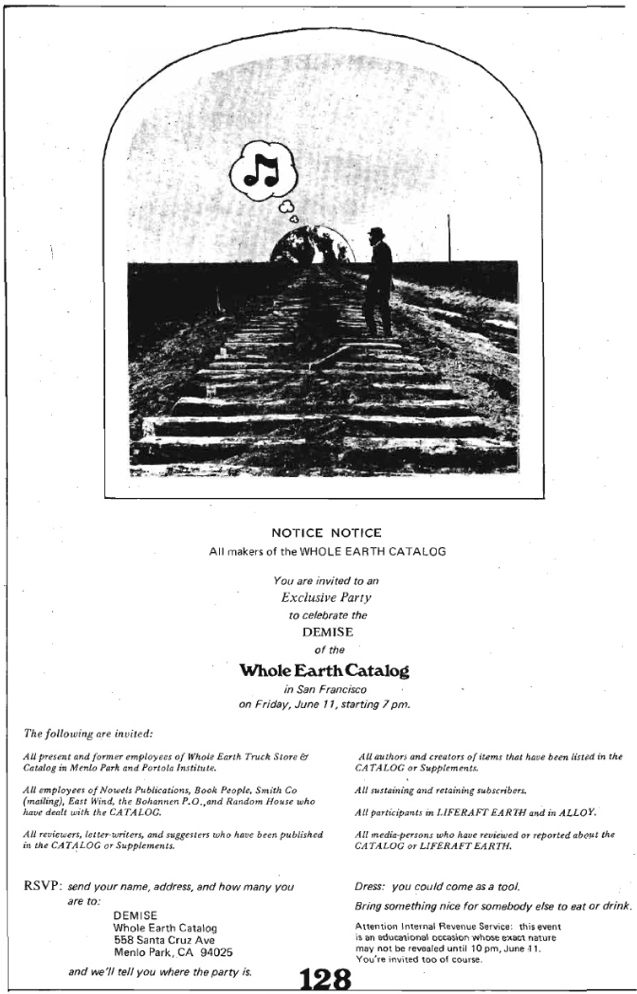
Among those who attended was Richard Brautigan, as related here:
The evening had just gotten started (hosted by Scott Beech, music by The Golden Toad) when all the glitterati of S.F. started showing up, including Richard Brautigan and another man passing out a “free poem” entitled “Lichen.” I tried to get the two of them to autograph the poem, which was printed on legal-sized, greenish paper. Both refused. Instead of stamping the backs of hands (so people could come and go), we had these stacks of self-stick diffraction gratings from Edmund Scientific to put on people’s foreheads. Both refused.
In Stewart Brand’s own tale of the party and its aftermath, he goes on to relate the story of POINT Foundation and its mechanism for handing out grants (emphasis mine):
It was not a bad overture for the founding of POINT, the foundation that took over from Portola the dispensing of Whole Earth’s soon sizable income. Dick Raymond and I appointed a board consisting of ourselves, Huey Johnson from the Nature Conservancy, Mike Phillips from Glide Foundation, Jerry Mander (radical ad-man), and Bill English from Xerox. The seventh director was always a guest, called “Elijah,” different each time we met.
The first thing we did was give up on my “Mountain Fantasy” notion of a bifurcated high hard community - too pushily experimental. Instead we focussed on being a needle in the gaseous foundation world. We ruled that none of us could be with POINT more than three years. We dispensed (Jerry Mander’s brilliant stroke) with group decision about money - each director had $55,000 a year to give out at his unchallenged discretion. We funded quickly and without fuss, usually preferring to do without proposals and such. We held board meetings on salmon boats at sea, in tipis, in Glide’s sex room, at the Black Panther school in Oakland. And our grants were maybe no worse than other people’s - they’re listed in entirety in the Summer ‘74 Co-Evolution Quarterly if you’re interested.
Huey Johnson and Jerry Mander, who fought constantly, were the best funders. Dick Raymond and I were terrible. Now there’s mostly a new set of directors, whose qualities we shall see. The main lesson I learned was: it’s not enough to give money to someone who’s very good. They must also be in the grip of an overwhelming idea which is very good; otherwise a hideous paralysis will take them over and, in addition, freeze your friendship.
My parents owned copied of the Whole Earth Catalog, and I’ve accumulated my own collection over the years (to the point where I’ve had enough extra copies that I’ve been able to share them with fellow travellers); I was a Whole Earth Review subscriber in later years, and a Well member too. If there’s an underlying rhyme to my reason, its roots can likely be found somewhere in the Whole Earth enterprise, for which I owe Brand and his coconspirators a great debt.
In the printing trade, one of the letterpress’s unique superpowers is the ability to print on irregularly-shaped things. Like coffee bags. And so, after picking up and afternoon coffee at Youngfolk & The Kettle Black every afternoon this winter, eventually the conversation was bound to come around to “so, what about printing up some coffee bags for us.” So I gave it a try.
It’s a tricky job because the folds in the coffee bag create a limited area of “flatness” and I need to accommodate room for the 3-times-fold and seal, so I’m left with a relatively small area to print on, and even within that area some folds I need to work around. I’m only halfway through right now: it’s a two-colour job, and I’ve only printed the black. But here’s what it’s looking like:
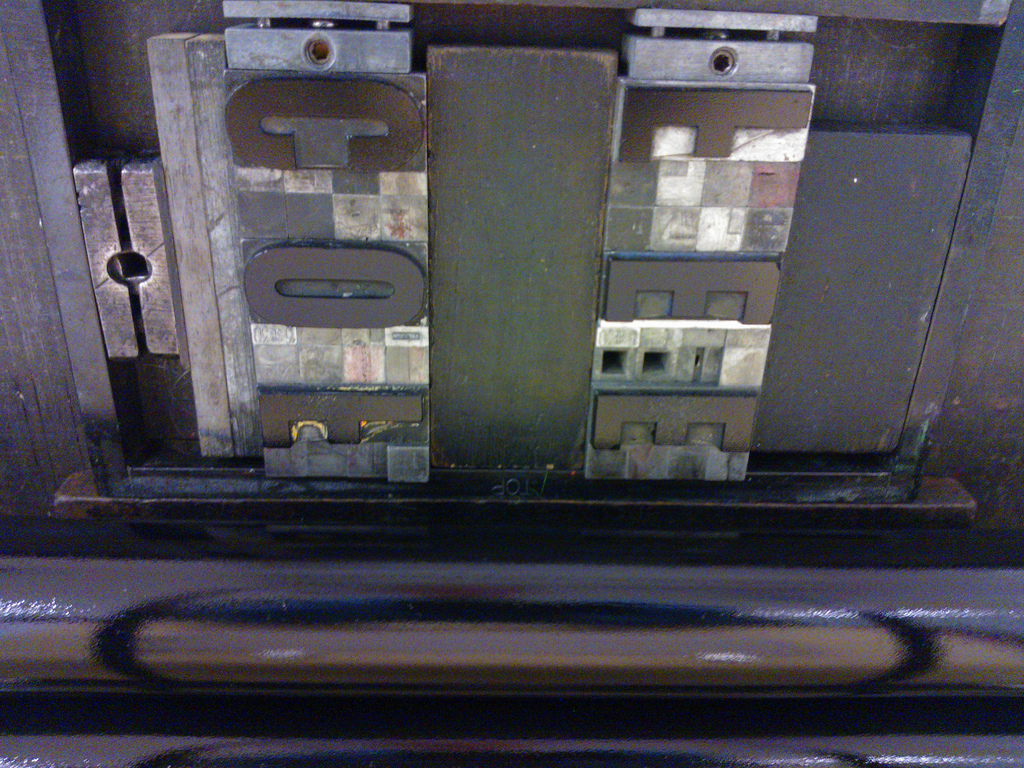
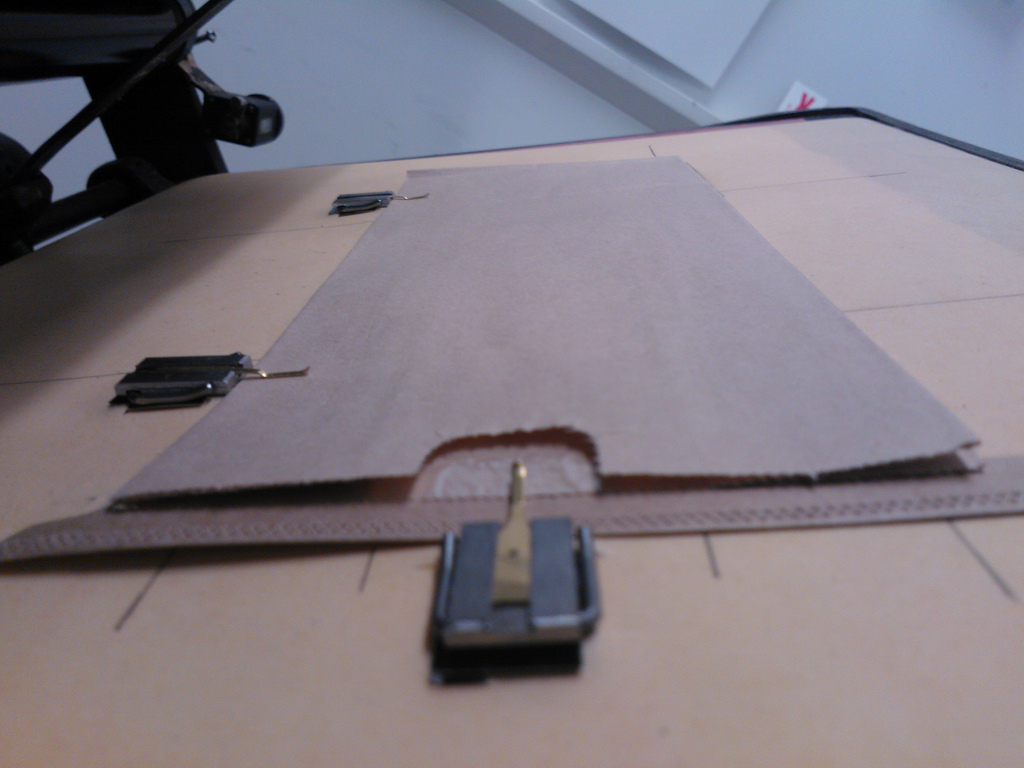
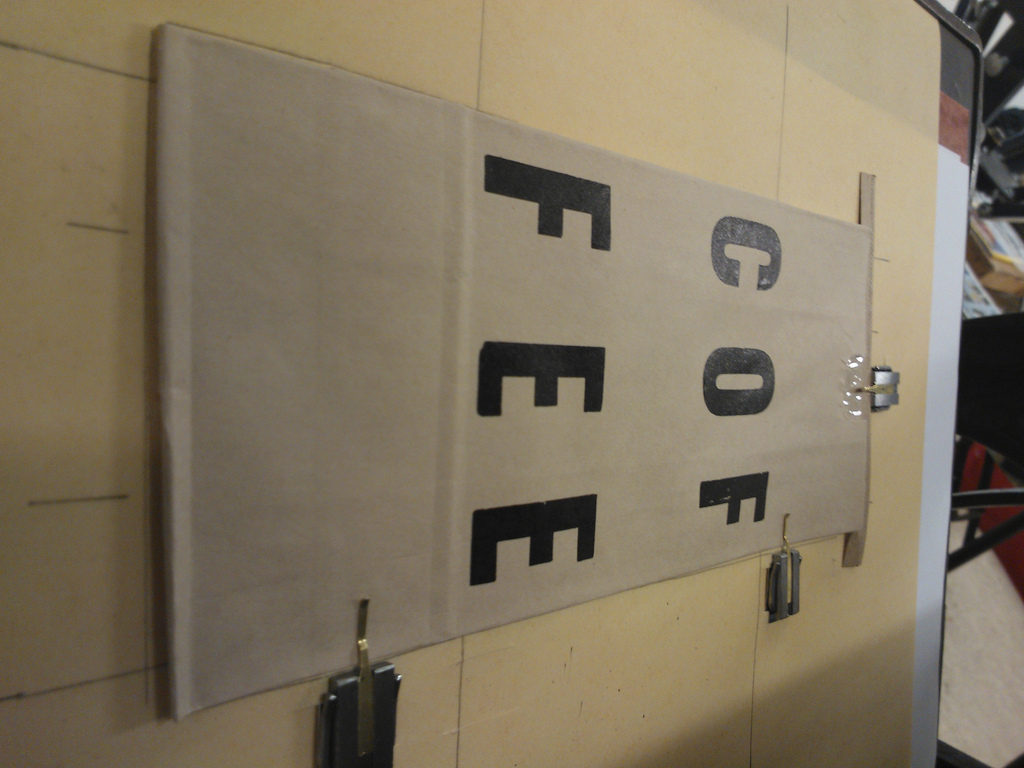
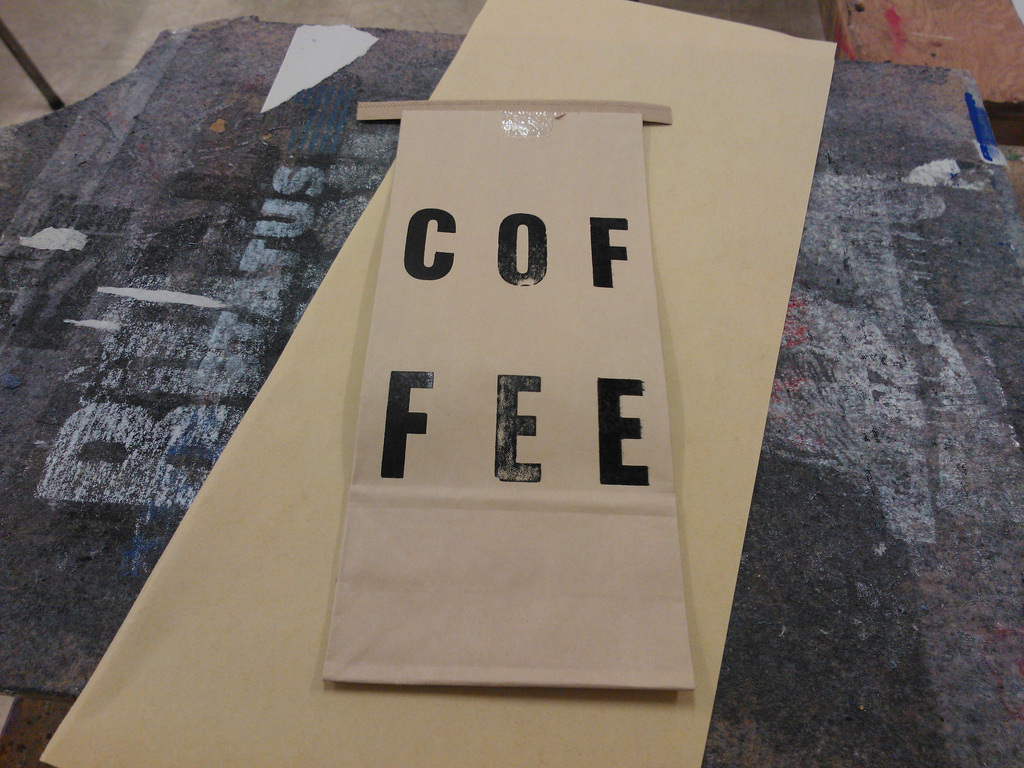
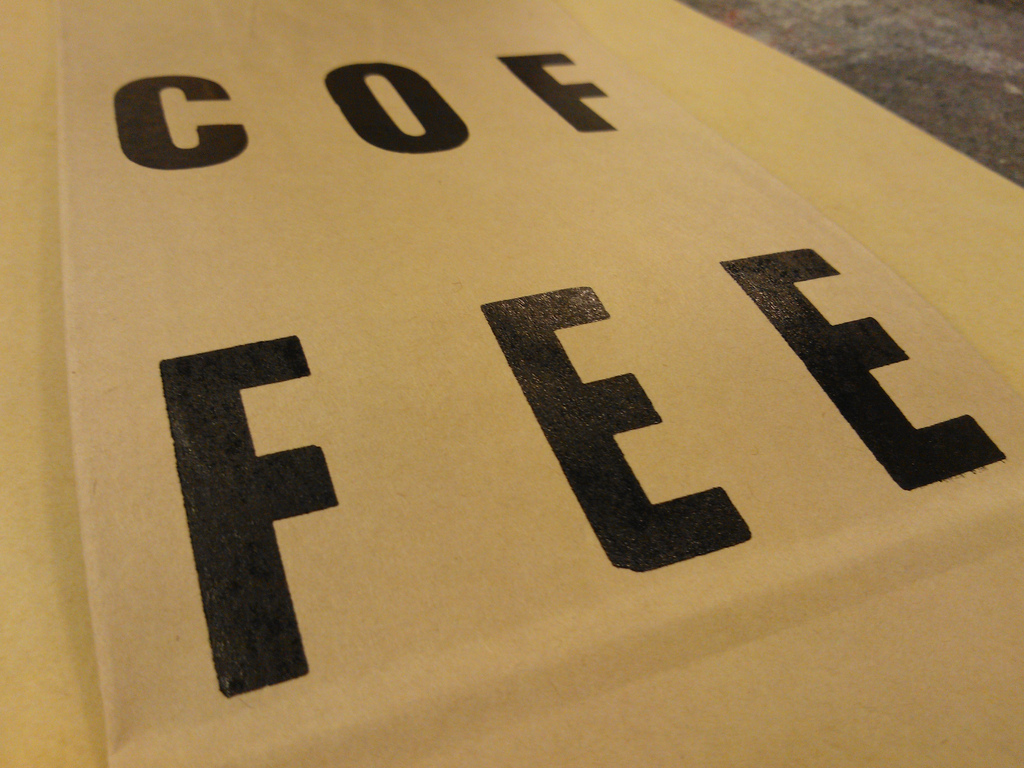
In red, between COF and FEE, will be some variation on Y&TKB or Youngfolk & The Kettle Black. Still working out the details. But I’ve got to wait for 150 coffee bags to dry, so I’ve got time.
 The lab is now full. There may be cancellations during the week. There is, however, a second, afternoon lab that might still have spaces.
The lab is now full. There may be cancellations during the week. There is, however, a second, afternoon lab that might still have spaces.
About the Lab
An informal opportunity to come and play Minecraft, the popular world-building game, with other people.
The emphasis will be on sharing what we know, on learning new tips and techniques: so please come with questions and answers, and your curiousity.
Who can attend?
You can be an absolute beginner, or a longtime player: we want to create an space for players of all skill levels to teach each other.
There is no age limit; people under 18 are asked to obtain permission from parent or guardian to attend, and parents are welcome to attend too, either to play or just to learn and help.
The lab is limited to 25 attendees, and you must register a spot in advance if you want to attend (parents or guardians accompanying player do not need to register).
Where is it?
The lab will be held in the Modern Language Lab at Robertson Library, University of PEI.
There is free parking on the UPEI campus, and the Charlottetown Farmer’s Market is just across the street and is a good place to stop for breakfast before or lunch after.
The lab is equipped with thirty 20” iMacs and a SMART board. We’ll be running our own Minecraft server in the lab so that players can play together.
How much does it cost?
The workshop is free.
You do NOT need to have a Minecraft account (but you can use your Minecraft account if you have one).
What do I need to bring?
If you have a Minecraft account already, please bring your username and password.
We’ll have 5 educational licenses to use for those that don’t already have a Minecraft account; if you’d rather get your own account before you come, you can purchase from Minecraft.net (and the account you buy there can be used both in our lab and at home).
Question from Parents?
Minecraft is being used by educators to teach everything from technology to engineering to math to architecture. The MinecraftEdu website is a good clearinghouse for information about the use of Minecraft in schools.
This lab is being organized by Peter Rukavina, Hacker in Residence, University of PEI. You can phone me at (902) 892-2556 or email prukavina@upei.ca is you have any questions or concerns.
 I am
I am